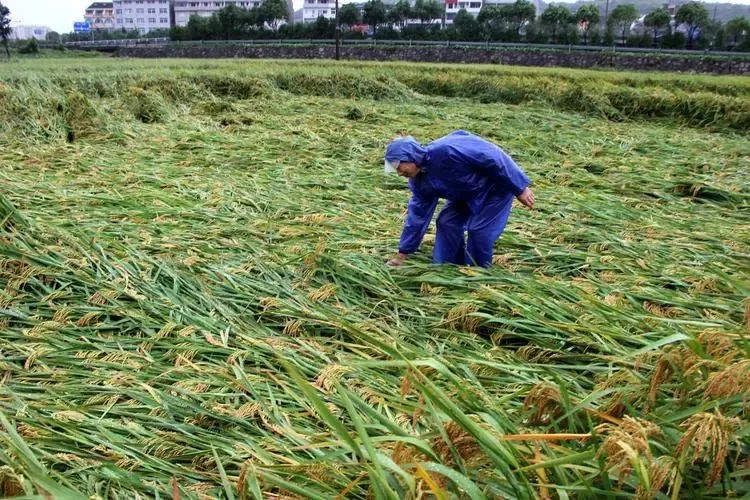Technical guidance on crop pest control is here after the floods!
Recently, by the impact of Typhoon "Dusu Rui" and other places, the southeast coast and other places suffered heavy rainfall, heavy rainfall in the Jianghuai, Huanghuai East and Beijing-Tianjin-Hebei and other places, some areas of the field more water, waterlogging, resulting in rice, corn, peanuts, soybeans, vegetables, and other crops, weak, more wounds, poor resistance, very favorable to the occurrence of various pests and diseases. In order to do a good job of preventing and controlling crop pests and diseases after typhoons and floods, and to reduce disaster losses, the National Center for the Promotion of Agricultural Technology has formulated the Technical Guidelines for the Prevention and Control of Pests and Diseases in Major Crops after Typhoons and Floods.

01 Control points
Rice pests and diseases. After the impact of heavy rain and typhoon, the field water layer is high, humidity is high, plant wounds are many, highly conducive to disease infestation and epidemic. After the disaster, it is necessary to seize the sunshine and grasp the early, and immediately spray thiazole zinc or thiamphenicol and other agents to prevent bacterial streak disease, white leaf blight, bacterial basal rot and other bacterial diseases from occurring. When acute spots or centers of leaf blight and stripe blight strains appear in the field, tricyclazole, chunamycin, Bacillus subtilis, shenzinomycin, doxycycline, as well as agents such as Inoculin A, Inoculin - Waxwaxbacteria, Mibuprofen - Flucycloxazole, Doxycycline, etc., can be used for prevention and control.
Under the influence of typhoon, rice fly and rice leaf borer can migrate in large quantities with rainfall, resulting in a sudden increase in the number of insects in the field. Rice fly in the lower part of the rice plant sucking plant, the damage is hidden, prevention and treatment is not timely and easy to cause "bubble through" collapse serious yield loss. When the rice fly field population reached 1,000 head / 100 clusters of prevention and control indicators, to seize the sunny spraying insecticide control, the agent can be used to choose the turtle green fungus CQMa421, Coccidioides albicans, ether pyrethrum, pyraclostrobin, allylpyrazine, furosemide, trifluorophenylpyrimethamine and other varieties. To pay close attention to the amount of moths and larvae in the field of the rice leaf roller, in the tillering stage of the rice field can be appropriately relaxed control indicators, the use of plant compensation ability and the role of natural natural enemies to control pests; single-season rice pregnancy to the spike period, when the rolled or bundled tips of the leaves to reach the control indicators of 60 / 100 clumps, you can use the collard nightshade moth nucleopolyhedral viruses, the golden turtle green stiffness of the microbial agents such as CQMa421, or chlorothalonilamide, indoxacarb, tetrachlorfenapyr and other chemicals for control.
Corn pests and diseases. Heavy rain, mud, flooding, etc. are prone to cause injury to corn plants and weakened resistance. To drain and dehumidify, plowing and loosening, spraying amino-oligosaccharides, brassinolide and other immune-induced resistance or growth regulators to enhance crop resistance on the basis of the maize basal rot, leaf spot, wilt and other bacterial diseases may reoccur in a timely manner, the spraying of pyrimidine nucleoside antimicrobials, wellbutrin and other agents for prevention and control.
For fungal diseases such as powdery mildew, brown spot, small spot, blight, southern rust, etc., agents such as carbendazim, pyraclostrobin, tebuconazole, etc. can be used for control. For migratory pests such as the grass greedy night moth and cotton bollworm, chlorpyrifos, mevinphos and other recommended drugs can be used for control.
Peanut pests and diseases. After the rain suddenly clear, high temperature and high humidity in the field is easy to cause peanut leaf spot disease, fruit rot, white silk disease, as well as the occurrence of cotton bollworm, twill moth, beet nightshade and other leaf-eating pests, should be immediately organized to carry out prevention and control. For peanut leaf diseases can choose biphenyl triadimenol, fluconazole, aliconazole, triadimenol, triadimefon and other fungicides for foliar spray prevention and control; peanut fruit rot can choose carbendazim, pyrimethanil, triadimefon, multi-antimycotic spray prevention and control; white sericosis can choose flutriafolamide, thiramide, and other fungicides to spray the plant stem base with water; cotton bollworms, leaf-feeding insects such as the twill moths, the available chlorpyrifos, metaviridin, and other leaf-feeding pests, can be used chlorpyrifos, chlorpyrifos and so on foliar spray. The following is a list of the most common pests that can be sprayed on the plant stems. When pests and diseases are serious, spray 1 more time 7-10 days after the first application.
Soybean pests and diseases. After the flood, the field humidity is large, easy to breed pests and diseases. The Yellow River and Huaihe region should focus on the prevention and control of soybean root rot, rust, downy mildew, gray spot disease and aphids, pod borer, heartworm and other pests and diseases. You can choose to use the fine methyl chlorothalonil, pyrazole-fluconazole, benzyl-propiconazole, pyrimethanil, carbendazim and other fungicides, imidacloprid and other insecticides, spray control. In addition, after the disaster, soybean growth is weak, sustained high temperatures and other easy to cause soybean green, foliar spray boron fertilizer and amino acids, amino-oligosaccharides, mushroom polysaccharides and other nutrients or immune-inducing antagonists to enhance the plant's own ability to resist adversity. At the same time, the choice of thiamethoxam, furosemide and other control point bee edge bugs, lice, thrips and other media pests.
Vegetable diseases. Floods lead to vegetable plant damage, weak resistance, coupled with high temperature and high humidity in the field, extremely conducive to melons, eggplant and fruit, cruciferous, leguminous vegetables and a variety of diseases. To dredge the drainage in a timely manner, plowing and loosening of the soil on the basis of poor growth, plant resistance to weak fields, timely spraying of amino-oligosaccharides, red - indoethyl - brassica and other immune-inducing antagonists to enhance plant disease resistance. To adhere to the principle of prevention, timely spraying of zinc manganese diclofenac, chlorothalonil, zinc diclofenac and other protective fungicides to prevent the occurrence of disease after the rain.
For the waterlogged epidemic, stem rot, green blight, root rot and other soil-borne diseases in high incidence, timely use of Bacillus subtilis, Bacillus polymyxa, Bacillus cereus, Mucor xylophilus, oxamylin, carbendazim, fumonisin and other agents for root irrigation or splashing treatment. For leaf and fruit and other parts of the disease, in the early stage of fungal diseases such as downy mildew, epidemic, anthracnose and other fungal diseases, spraying oligochromene rot, polymyxin, enamorphine, flupyradifenacoum - enamorphine, frost fungicide, pyrazole ethermide, benzoxyfenpyrazole, ethermide, pyrimethanil, and other agents for prevention and control; for bacterial diseases such as soft rot, bacterial horn blotch and other bacterial diseases, can be sprayed with mesotryptophilus, For soft rot, bacterial horn blotch and other bacterial diseases can be sprayed with mesocarbophil, thiabendazole, zinc thiazole, copper hydroxide, copper succinate, quinoline ketone and other agents to prevent and control. Pay attention to the alternation and safety interval when using drugs.
02 Precautions
Pay attention to the scientific use of drugs. After the typhoon and flooding emergency application of drugs to prevent pests and diseases, pesticide varieties should be selected high content of a single agent, avoid the use of low-content compounding agent, to ensure the effectiveness of prevention and control. A variety of fungicides, insecticides mixed, should pay attention to the different varieties of pharmaceutical mixing requirements, to avoid interactions affect the efficacy.
Choose the right medicine. After the disaster, more water in the field, soil humidity is not suitable for artificial and large-scale machinery to work in the field, you can choose to use plant protection drones and other aerial plant protection equipment spraying operations, mu spray liquid volume of not less than 1.5 liters, and in the liquid to add vegetable oils, silicones and polymers such as sedimentation agents, anti-evaporation agents and other additives suitable for flight control. The drier fields of large-scale operations can choose ground self-propelled spray bar sprayer, mu spray liquid volume is generally controlled at 10 ~ 15 liters, small area operations can be used manually backpack sprayer, mu spray liquid volume is generally controlled at about 15 liters.
Prevent poisoning accidents. After the rain, high temperature and high humidity weather field drug application is prone to heat stroke and poisoning accidents, drug application operation time try to avoid the high temperature at noon, choose to carry out before 9:00 a.m. or 16:00 p.m., in case of wind greater than 3 above or rainy weather, should stop drug application. Pay attention to the safety protection when applying medicine, wear good protective clothing, masks, gloves and other protective equipment. Do not eat or smoke during the application process to avoid poisoning accidents. After application, wash hands, take a bath, change clothes and clean the spraying instruments.



 Mobile: 86-13012553585 15610518510
Mobile: 86-13012553585 15610518510 Phone (Fax):86-53283197178
Phone (Fax):86-53283197178 E-mail: admin@bluealga.com
E-mail: admin@bluealga.com Add:No.918 Lingang 8 Road Huangdao District,Qingdao China 266400
Add:No.918 Lingang 8 Road Huangdao District,Qingdao China 266400

